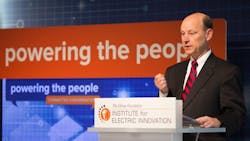PG&E President Says Utility is Investing Today for the ‘Grid of Things’ of Tomorrow
In a keynote address on March 19 in Washington, D.C., PG&E President Chris Johns laid out the company’s vision for a 21st-century power grid equipped to maximize the use and benefits of a growing array of advanced energy technologies available to utilities and their customers, from electric vehicles and rooftop solar to smart appliances and battery storage.
Johns spoke at “Powering the People: Connected Conversations,” an event at the Newseum sponsored by the Edison Foundation Institute for Electric Innovation (IEI). Johns is co-chair of IEI’s management committee.
Johns said: “Our customers expect us to develop, build and maintain a grid that allows them to take full advantage of all of the new energy technology that we are seeing today—and in a way that gives them maximum flexibility, maximum choice in how they use energy, and ultimately maximum value. At PG&E, we’re thinking of this type of grid as the Grid of Things.TM”
Much like the tech industry’s concept of the “internet of things,” PG&E’s vision of the Grid of ThingsTM is a “plug-and-play” platform that allows emerging energy technologies to be interconnected with each other and integrated into the larger grid in ways that optimize their capabilities and benefits for customers.
Johns discussed several initiatives underway that bring the Grid of Things to life, including:
- A major smart-charging pilot program with automaker BMW that pays electric vehicle owners for the use of their batteries as tools in stabilizing the grid.
- PG&E’s new community solar program that will give customers the choice to cover either 50 percent or 100 percent of their electricity use with power from small and midsize solar projects within the utility’s service area.
Johns also discussed the importance of ongoing utility infrastructure and technology investments to help create the Grid of ThingsTM. This includes:
- Smart grid technology to help the grid “self-heal” to minimize outages.
- Voltage control technology that manages the two-way flow of electricity on the grid, given the increasing amount from distributed resources such as rooftop solar.
- New infrastructure to enable the broader adoption of electric vehicles, such as PG&E’s proposed network of 25,000 EV chargers.
“We have the opportunity to enable an even better, smarter energy future for our kids and grandkids. And the path to that future runs through the 21st-century electric grid,” Johns said.
